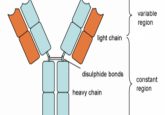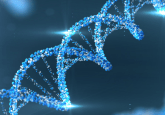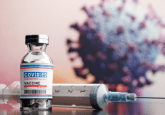Pro-antibodies gain a new inhibition

Researchers devised a new method for generating protease-activated pro-antibodies, which prevent side effects that occur when therapeutic antibodies bind targets in healthy cells instead of diseased cells.

A key advantage of using monoclonal antibodies (mAbs) to treat various diseases such as cancer is the very high specificity of their binding to the target molecule. However, systemic injection of a therapeutic mAb can cause major problems when the target is expressed not only in the diseased cells but also in normal cells. For instance, mAbs have been developed to target epidermal growth factor receptor (EGFR), which is overexpressed in various types of cancer. EGFR is also expressed in normal cells, so systemic injection of anti-EGFR mAbs can cause side effects, such as a skin rash.
One solution to this problem is to allow mAbs to only bind targets on diseased cells. This can be done by masking the antigen binding site of the mAb with a peptide to form a pro-antibody (or probody). The masking peptide is connected to the mAb by a short linker peptide containing the recognition site for a protease that is expressed only by the diseased cells, such as one of the matrix metalloproteinases (MMPs) typically overexpressed in many tumors. Protease cleavage of the linker releases the masking peptide, converting the pro-antibody to the mature mAb, which then binds the target molecule only on diseased cells.
Scientists have developed several types of masking peptides for pro-antibodies. The peptides can be selected by phage display to block the antigen binding site of the mAb, but these may be immunogenic and induce neutralizing antibodies. Alternatively, epitope sequence peptides bound by the mAb can be used, but these can bind with such high affinity that they may not dissociate from the mAb after the protease cleavage.
Now, researchers led by Tian-Lu Cheng and Shey-Cherng Tzou have developed a novel approach for creating pro-antibodies that overcomes the drawbacks of affinity-based masking peptides by using an inhibitory domain that appears to be applicable to any mAb, eliminating the need to generate a specific masking peptide for each therapeutic mAb.
As candidates for inhibitory domains that could block the antigen binding site of a mAb, the team considered the pro-domains of three proteins that needed to be cleaved off in order to activate the protein: the latency-associated protein (LAP) of transforming growth factor-β (TGF-β), the C2b domain of complement factor 2, and the CBa domain of complement factor B. These were selected because they are endogenous proteins that should not be immunogenic and have no biological activity apart from inhibiting their original proteins. Also, since they work by steric hindrance, the pro-domains should easily separate from the antibody after protease cleavage.
Cheng and Tzou attached these domains to the N terminus of the heavy chain of an anti-EFGR mAb by a linker peptide containing a cleavage site for MMP-2. Treating the three different pro-antibodies secreted from transfected cells with MMP-2 resulted in cleavage of the inhibitory domain and the formation of the mature mAb.
A cell-based ELISA using EGFR-expressing cells as the antigen target demonstrated that the LAP domain was the only one to significantly inhibit binding of the mAb (>50%) and that MMP-2 treatment fully restored binding of the mAb after a 1-hour treatment with MMP-2. The binding kinetics of the MMP-2 treated LAP-anti-EGFR antibody were similar to those of the unmodified anti-EGFR antibody.
Given their success in using the LAP domain to mask the anti-EGFR mAb, the team tested whether the domain could be used as a universal binding inhibitor in pro-antibodies by testing it with an anti-TNF-α antibody. Again, the LAP domain was able to significantly inhibit binding of the mAb (>50%) and could be efficiently cleaved off by MMP-2 to restore 100% binding of the antibody.
This proof-of-principle study suggests that this approach for generating protease-activated pro-antibodies using the LAP inhibitory domain could be applicable to other antibodies, which should greatly facilitate the production of these disease-cell-specific mAbs and encourage their adoption for the treatment of various diseases.





